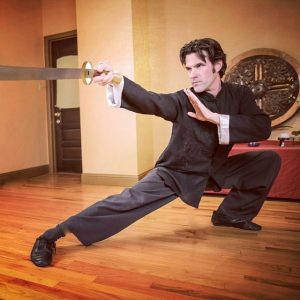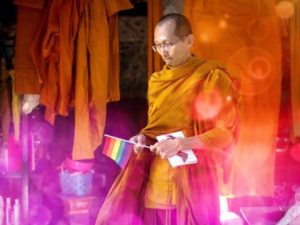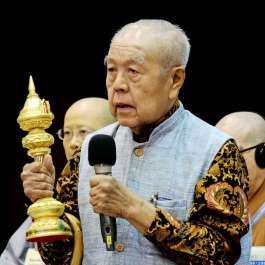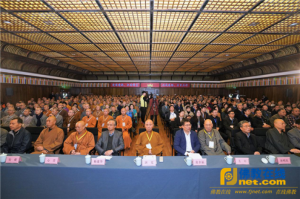
For thousands of years, men and women alike have worn jewelry and other forms of adornment to accentuate beauty, status, and personal expression. Visualizing oneself as the deity means dressing well. And adding flourishes of fabric, beads, metals, and precious materials is a form of offering and homage. As a successful artist, who has been painting, drawing, and constructing for three decades, Iva Hladis never imagined she would be drawn to the fabric arts. However, when she received a surprise gift of a beautiful bunch of unspun raw wool, the naturalness of the material spoke to her. Iva’s felted jewelry blurs the line between sculpture and accessory. While clearly worn as a necklace, each piece evokes both the natural sheep’s wool, which is usually spun into yarn for use as fabric, and the ingenuity of using such a material for fine art jewelry. Her pieces, with their handmade heirloom quality, are sensual to the touch and as enjoyable as a fine wool scarf or sweater. For the artist, creating each piece is an act of meditation, and each creation is an offering of adornment to please both the wearer and the beholder.
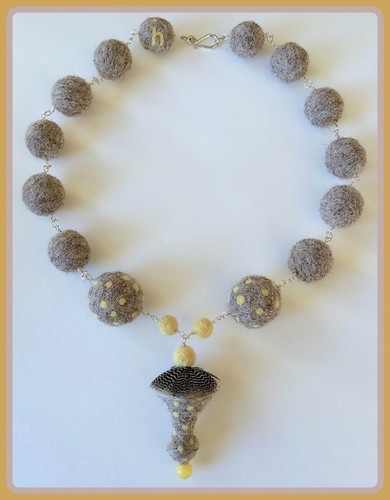
About her Legacy necklace, Hladis says: “This was my second creation. I decided to use easy-to-understand shapes for the ‘base’ of the necklace and to then be a little bit more experimental with the pendant. I had an idea about the shape, but not a 100-per-cent-sure plan. It is just like this, when I approach the process of painting. As the shapes start to form, I make adjustments to my initial idea for the final design. The key element of Legacy is the way the pendant relates to the rest of the necklace. The three yellow ‘beads’ in the design led me to the final detail on the pendant. But that was not quite enough. I kept experimenting with different ideas, but none of them worked, until I took out my feather collection. There I found just the right finishing touch. The feathers and wool both came from The Legacy thrift store, hence the name of the necklace: Legacy.”
How Hladis arrived at this juncture in her creative life is a long story. As a young girl growing up in communist Czechoslovakia, she learned all her skills from her mother out of necessity. Together they made all her clothes. She learned how to sew, knit, embroider, and crochet. If Iva wanted something, she had to make it herself. Because of this, she developed a strong sense of personal style: “I have memories with one particular teacher making remarks about my outfits, especially later in my teenage years when I went through my ‘flower child’ period. Flash forward a few years to my escape from Czechoslovakia, in July 1985. Once I reached the border between Yugoslavia and Italy, it took a 24-hour climb to reach Tarvisio, Italy. At that moment, I became a temporary immigrant in Italy, the fashion capital of the world! I was mesmerized by all that I saw in the shop windows. I had no money whatsoever, so I could not buy anything. All I had at the end of my time in Rome was holes in my shoe soles and memories of beauty and style.”
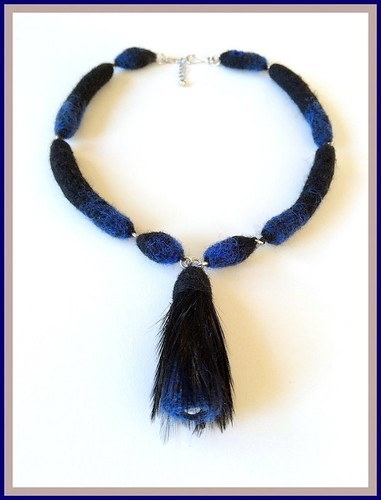
Buddhistdoor Global: Why did you start felting wool?
Iva Hladis: When I moved to my first loft in downtown Los Angeles, I met a studio jeweler through a mutual friend. She was looking for an assistant and I took the job. I remained at the job for 22 years and I learned everything I needed to know about jewelry-making hands on, which is the best way to learn. When I left LA and settled in my new home in West Sonoma, I was given a box of raw wool for my birthday. The gift came from a very special friend and at first I thought that the box was the gift, since it weighed nothing. A lot of thought and love went into this choice of gift, and I knew I had to use it creatively. But what should I do? Get back into knitting? I thought about various options, but felted jewelry was the most exciting one. My first necklace, Tulip—named after the sheep where the wool came from—was a success. I sold it immediately. What a great boost for the creative soul!
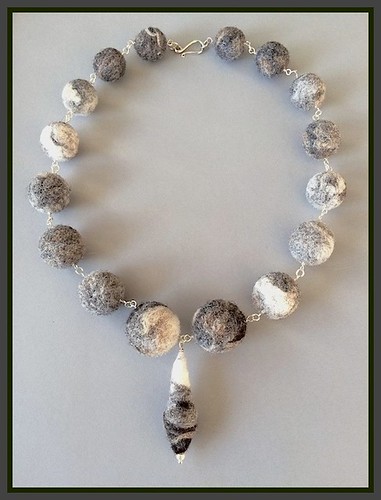
BDG: How did you come to these particular techniques, shapes, and forms?
IH: I started with easy forms, easy for women to enjoy and for me to get the hang of the craft. Also, the wire wrapping is a very popular way of assembling today’s jewelry. Once I achieved that part, I started to move onto more intricate forms that require some engineering as well. In terms of design, I tend to alternate between the basic and the unexpected.
BDG: What is your process?
IH: Just like with any other art media I work with—fine pencil drawing, painting, and sculpture—needle felting is very detailed work and very time consuming. I find it quite meditative. It brings such satisfaction to my soul, watching the shapes emerge and the details enhance the final product. Sometimes I control the final outcome, but many times I just let the natural quality of the wool lead me. The results are gorgeous, as nature is flawless. I approach my studio time devoted to felting (as I do to any other creative process), with a fresh, early-morning mind, a fresh pot of green tea, and often without sound (radio, music, or podcasts), just the sounds from the wilderness. Lost in time, I usually find myself hours later poking my wool with such satisfaction that only my hunger makes me take a break. For me, this time spent working the wool feels like sitting in Zazen meditation, with my cat Sophie as a fellow practitioner. As I create I watch thoughts come and go . . . and I feel at peace.
BDG: Why do these particular materials appeal to you?
IH: As I mentioned, the wool was a real gift that expanded my creativity. The wires and different findings came from my drawers of supplies that I have been gathering for many years (for my Origins Extinct series). I always select very carefully what to add to my collection of findings, and I source things from everywhere. I started with a small handful of leftover feathers from a job—a couture jewelry line for the Tom Ford fashion house. I loved creating that work. It was very intricate, and the final result was so gratifying! Those leftover feathers, together with others found in the local thrift stores, and some from around my ranch (from poor birds killed by predators) came to good use. Since I have been all about re-purposing, in my personal and professional life, all the feathers find their way to being re-used and admired again.
BDG: What does adornment mean to you as a woman? And as an artist?
IH: Adornment to me is everything. If a woman takes on a style of her own and adornments are part of this style, she is able to express so many ways of being, of feeling. She can express encouragement or an ancestral style. Women can experiment and I love to see that; I love to see a very individual style in a woman. It is so refreshing, especially in today’s fashion world of magazines and catalogs, that tell you what is hip and what one should wear. For me, being a creative person on so many levels, I feel fortunate that I can make what I want. For example, my High Priestess necklace has nothing to do with fashion trends. It was a pure expression of me, where I am in my life now and how I feel. It is my “power necklace” if you will.
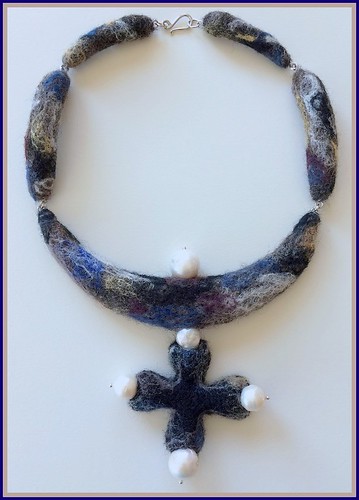
Iva’s work speaks to the divine feminine in all of us, and shows not only that wearing beautiful adornments is an offering, but also that their creation can be a meditation in itself. As Marlie de Swart, proprietor of Black Mountain Artisans Shop in Point Reyes Station says, “Iva Hladis’ felted art jewelry is unique, different, and precious, with a European sense of aesthetics. Her exquisite craftsmanship enhances the contours of her shapes. Anyone would be lucky to have the work of this promising felt artist.” I would add that wearing her art makes you feel like a true dakini.
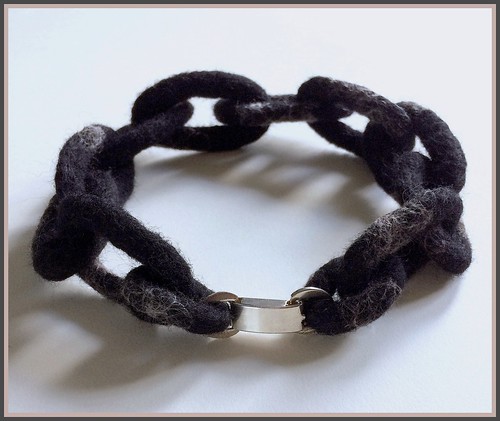
See more
Iva Hladis
Moondrop by Sarah C. Beasley
Related features from Buddhistdoor Global
A Thousand Buddhas on My Body: A Miao Girl’s Festival Attire
From Manga to Monks, Anime to Arhats: Recent Buddhist Themes in the Art of Takashi Murakami
The Bell-maker’s Daughter: A Journey in Dharma Art
Threads of Generosity — The Work of Artist Lee Mingwei
Related News from Buddhistdoor Global
American Buddhist Women — On Race and Politics
Chinese Artist Tian Xuesen Finds Inspiration and Self-realization in Mountain Seclusion









